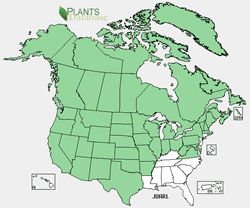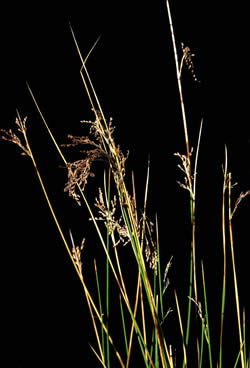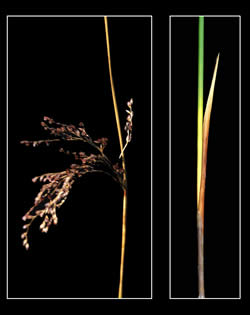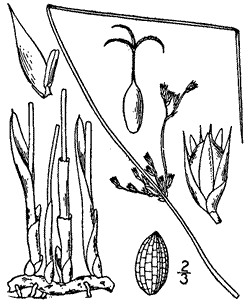Plant of the Week
 Juncus arcticus range map. USDA PLANTS Database.
Juncus arcticus range map. USDA PLANTS Database.
 Inflorescence of Juncus balticus Salt lake City, Utah. Photo by Bill Gray.
Inflorescence of Juncus balticus Salt lake City, Utah. Photo by Bill Gray.
 Close-up of Juncus balticus flowers (left) and leaves (right), Salt Lake City, Utah. Photo by Bill Gray.
Close-up of Juncus balticus flowers (left) and leaves (right), Salt Lake City, Utah. Photo by Bill Gray.
 Baltic rush (Juncus balticus) roots, stems, flowers, and seed. USDA-NRCS PLANTS Database / Britton, N.L., and A. Brown. 1913. An illustrated flora of the northern United States, Canada and the British Possessions. 3 vols. Charles Scribner's Sons, New York. Vol. 1: 468.
Baltic rush (Juncus balticus) roots, stems, flowers, and seed. USDA-NRCS PLANTS Database / Britton, N.L., and A. Brown. 1913. An illustrated flora of the northern United States, Canada and the British Possessions. 3 vols. Charles Scribner's Sons, New York. Vol. 1: 468.
Baltic Rush (Juncus arcticus)
By Walter Fertig
Baltic rush (Juncus arcticus syn. J. balticus) is one of the world’s most widespread plant species, ranging across northern Europe and Asia, most of western and northeastern North America, and down to the Andes of South America. Given its large distribution, it is not surprising that populations can be quite variable and taxonomists disagree on how many subspecies should be recognized and whether Baltic rush is a single species or should be split into several segregate taxa. Even the correct name is debated, with the pendulum currently favoring Juncus arcticus (the Arctic rush) over Juncus balticus (the Baltic rush) though a 2002 taxonomic revision recognized both as distinct.
In North America, experts generally recognize three main forms of Baltic rush which differ in flower proportions and in the leafiness of the stems. All can be recognized by their grass-like appearance, wiry stems (wiregrass is another common name) wrapped in scale-like leaf bases near ground level, elongate, black, woody rhizomes, and clusters of brownish-purple flowers that seem to erupt out of the side of the stem below the tip. Technically, the inflorescence is terminal and the extension of the stem is actually a modified leaf or bract that is nearly identical in color and texture to the rest of the stem. Individual flowers are small but have the full complement of parts typical of a monocot: 3 sepals, 3 petals, and 3-6 stamens surrounding a 3-parted ovary. In this regard, the flowers of Baltic rush and other species in the rush family (Juncaceae) are more like those of lilies than their close relatives, the grasses (Poaceae) and sedges (Cyperaceae).
Besides differing in floral features, rushes also can be distinguished from grasses and sedges by their solid, round stems. By comparison, sedges have 3-sided stems, and grasses have hollow, round stems. The rhyme “sedges have edges, rushes are round, and grasses are hollow right up from the ground” has helped countless plant taxonomy students remember these differences at exam time.
Baltic rush is often one of the dominant species in wet meadow and valley bottom sites, especially where the soils are somewhat alkaline as in extensive areas of western North America. The plant’s thick rhizomes are important for binding wetland soils and the stems can provide forage for livestock and native grazers when young and tender. With age, the stems become too coarse for most animals to digest, though the fruits and birds eat minute seeds. Studies have also shown that Baltic rush is an important species for fixing nitrogen in wetland soils. The unusually thick stems of the Andean variety of Baltic rush are used by native peoples in basket weaving and other handiworks.

